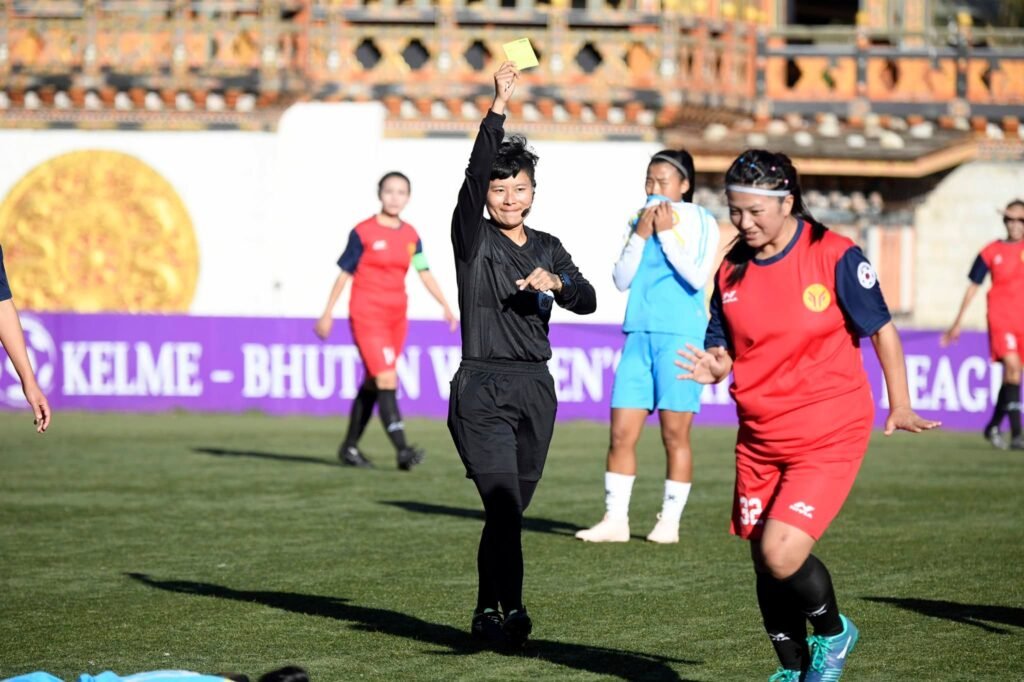WELCOME TO BHUTAN WOMEN'S TEAM
A few years back, for every fifteen boys, there may have been three girls playing football. The rough estimate is not suggestive of inequality or disparity but rather a reflection of the nascent state of women’s and girls’ football in the country. Unfortunately, we do not have a rich documentation on the history of women’s football in the country. The word and recollection from our veteran players are that women’s football only truly began in 2004. 2004 isn’t light years away but just a few decades ago. One might assume that eighteen years is ample time for women’s and girls’ football to develop, and it is. However, we must also acknowledge and consider the stereotypical notion, stigmatisation and restraints from the parents and society for our girls to partake in football. Fortunately, the current and the future state of women’s and girls’ football in Bhutan is not so grim. Presently, the ratio of playing football at least at the grassroots level is equal.
Over the years, the number of female players has most certainly increased. Now it is just a matter of harnessing quality in our numbers.
STATS
A few years back, for every fifteen boys, there may have been three girls playing football. The rough estimate is not suggestive of inequality or disparity but rather a reflection of the nascent state of women’s and girls’ football in the country. Unfortunately, we do not have a rich documentation on the history of women’s football in the country. The word and recollection from our veteran players are that women’s football only truly began in 2004. 2004 isn’t light years away but just a few decades ago. One might assume that eighteen years is ample time for women’s and girls’ football to develop, and it is. However, we must also acknowledge and consider the stereotypical notion, stigmatisation and restraints from the parents and society for our girls to partake in football. Fortunately, the current and the future state of women’s and girls’ football in Bhutan is not so grim. Presently, the ratio of playing football at least at the grassroots level is equal. Over the years, the number of female players has most certainly increased. Now it is just a matter of harnessing quality in our numbers.
The development of women’s games isn’t solely dependent on the players. There are quite a few key stakeholders who are important assets for the growth of women’s football. We have three (3) female AFC A licence coaches, fourteen (14) B licence coaches, and thirty-one (31) C licence coaches. We also have six well-established women’s clubs partaking in the National Women’s League every year but in 2022 we will see ten clubs partaking in the National Women’s League. By the end of 2022, the Federation will have also built and established a National Club Licensing framework for our women’s club with support from FIFA. Club licensing is a step toward the professional management of our clubs and ensuring the clubs’ financial stability which is of paramount importance in the overall development of the game.
Although women’s football is still in its early stages in Bhutan, we are beyond thrilled to see the growth of women’s football across the globe. Such growth is an inspiration for a small Himalayan kingdom such as us and shows how much potential and opportunities there are for us.

The development of women’s games is not solely dependent on the players. There are quite a few key stakeholders who are important assets for the growth of women’s football. We have three (3) female AFC A license coaches, fourteen (14) B license coaches, and thirty-one (31) C license coaches. The numbers are just as high in our refereeing department with sixteen (16) referees of whom two are members of AFC’s Elite referees.
We also have six well-established women’s clubs partaking in the National Women’s League every year but in 2022 we will see ten clubs partaking in the National Women’s League.
MISSION: To provide an accessible and safe environment for all female players to learn and develop their skills at all levels through quality coaching, grassroots development, competitions and educational programs.
By the end of 2022, the Federation will have also built and established a National Club Licensing framework for our women’s club with support from FIFA. Club licensing is a step toward the professional management of our clubs and ensuring the clubs’ financial stability which is of paramount importance in the overall development of the game.
Although women’s football is still in its early stages in Bhutan, we are beyond thrilled to see the growth of women’s football across the globe. Such growth is an inspiration for a small HIMALAYAN kingdom such as us and shows how much potential and opportunities there are for us.
VISION: Enhance and raise the quality of women’s and girls’ football by enabling all stakeholders to reach their maximum potential.










